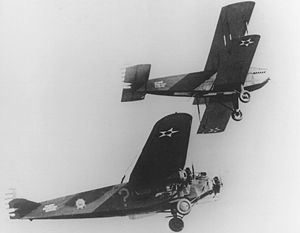Douglas C-1 Video - Picture

|
|
Douglas C-1
Douglas C-1

Picture - The Question Mark (bottom) being refueled by a Douglas C-1 (top)
Role: Transport
National origin: United States of America
Manufacturer: Douglas Aircraft Company
First flight: May 2, 1925
Introduction: 1925
Primary user: United States Army Air Service
Number built: 26
The Douglas C-1 was a cargo/transport airplane produced by the Douglas Aircraft Corporation for the United States Army Air Service starting in 1925.
Douglas received an order for nine single engined transport aircraft in 1925, the first aircraft flying from Douglas's Santa Monica, California factory on May 2, 1925. The C-1 was the first plane assigned in the new C- category. The aircraft design was based on several earlier and similar designs developed by Douglas in the early 1920s (including the Douglas World Cruisers used in the first round-the-world flight in 1924). The C-1 featured an enclosed passenger compartment capable of carrying six passengers or about 2,500 lb (1,100 kg) of cargo. A trap door was placed in the lower fuselage to allow large and/or heavy cargo (particularly aircraft engines) to be lifted directly into the cargo compartment. An auxiliary door for passengers and light cargo was included on the right side of the center fuselage.
The C-1 biplane was powered by the Liberty L-12 engine and carried a crew of two in an open-cockpit. A C-1 was flown in the 1926 Ford National Reliability Air Tour.
Several C-1s were used in test programs -- as an engine test bed, as a prototype air ambulance and as refueling aircraft for early air-to-air refueling experiments. Two of these aircraft were used as "tankers" in the 1929 record endurance flight of the Fokker C-2 Question Mark.
Seventeen additional aircraft were ordered in 1926 and 1927 for the United States Army Air Corps as C-1Cs and were slightly larger than the original C-1s.
Variants
C-1 Single-engined cargo/passenger transport aircraft, powered by a 435-hp (324-kW) Liberty V-1650-1 piston engine, accommodation for two crew and six to eight passengers. C-1A One C-1 used to test a variety of engines and cowlings, it was also used for number of experiments with ski landing gear. C-1C Single-engined cargo/passenger transport aircraft, fitted with a metal cabin floor, modified landing gear, it had a higher gross landing weight and increased dimensions, plus a new balanced rudder; 17 built
Operators
United States
United States Army Air Service
United States Army Air Corps
Specifications (Douglas C-1)
Data from McDonnell Douglas Aircraft since 1920
General characteristics
Crew: Two
Capacity: Six passengers or 2,500 lb (1,100 kg) cargo
Length: 35 ft 4 in (10.77 m)
Wingspan: 56 ft 7 in (17.25 m)
Height: 14 ft 0 in (4.27 m)
Wing area: 805 ft² (74.8 m²)
Empty weight: 3,836 lb (1,770 kg)
Loaded weight: 6,443 lb (2,922 kg)
Powerplant: 1x— Liberty V-1650-1 V-12 water cooled engine, 435 hp (325 kW)
Performance
Maximum speed: 101 kn (116 mph, 187 km/h)
Cruise speed: 74 kn (85 mph, 137 km/h)
Range: 335 nmi (385 mi, 620 km)
Service ceiling: 14,850 ft (4,525 m)
Rate of climb: 645 ft/min (3.3 m/s)
Wing loading: 8.00 lb/ft² (39.1 kg/m²)
Power/mass: 0.068 hp/lb (0.11 kW/kg)
Bibliography
Francillon, René J. McDonnell Douglas Aircraft since 1920. London:Putnam, 1979. ISBN 0-370-00050-1.
Douglas C-1 Pictures
More aircraft.
Source: WikiPedia